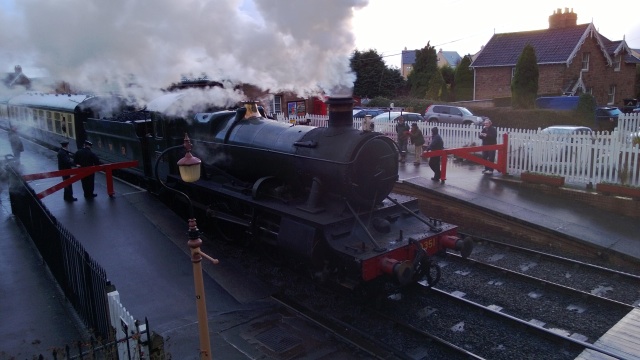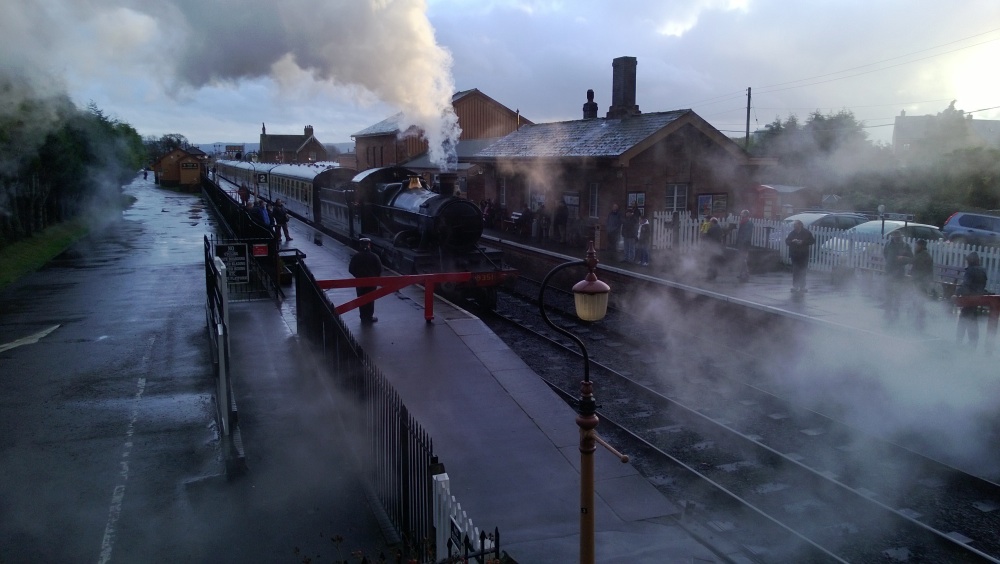Let's start with the photo in question - it's nothing earth shattering in the pantheon of photographic masterpieces, I guess, but it did turn out surprisingly well - very atmospheric, and garnered a load of positive feedback when I posted it to Twitter a few days ago.
Feel free to click on the photo to download the 2MB original or enlarge it further in your browser:
Now, this is no bright sunlight easy snap - I had to work to get something this artistic, pleasing and generally usable. Yet what you see is exactly what came out of my phone's camera, unedited and unretouched.
Here are some of the things that went to make up this photo - its 'anatomy', if you will:
Light, conditions
You should never rule out a photo opportunity just because the weather's inclement. Yes, I know everything has far more colour when the sun's out, but this was a gloomy winter's day and I had just a small hint of sunny sky to play with - it was tipping it down with rain either side of the steam train departure. Now, not every subject would suit a rainy, gloomy day, but I thought a steam train shot might prove atmospheric and indeed it did.
Equipment
It's all very well saying you have a camera in your smartphone and that you can just snap away, but the results have got to be half decent. In this case, I was using the Nokia Lumia 920, which I thought would do well, shooting handheld in the challenging light, but many recent smartphones (or some old Nokia classics) would also have done. With a camera phone without optical image stabilisation, you'd be best advised to at least rest the phone on a fence or bench or similar, to keep the shot crisp even with the long shutter times if you're in low light too.
Preparation
It has become a cliche, but the advice is just as essential as ever. In these days of camera glass which is totally unprotected, you need to take five seconds to clean it with a tissue or similar before any important shots. Shooting through a fingerprint will utterly disappoint.
In my case, I also had to contend with raindrops - there were quite a few on the phone screen, but I was careful to shield the back of the phone whenever possible. A rain drop on the small camera glass will act as another lens and will completely distort the image!
Direction
Normally, working out the direction of the strongest light source is essential, to avoid most subjects turning into silhouettes, but here the only very weak and occasional sun was off to the right and not a factor. And, obviously, with no visible sun at all, it won't matter much which angle you shoot from.
Angle and framing
This is where things get more artistic. It helps to have a picture in your mind, an expectation of how you want the photo to look. In this case, I wanted enough of the full scene to be present (i.e. people, railings, train, platform buildings, signal) and I also wanted to give viewers a sense of 3D - so I positioned myself off by 30 degrees or so from the train's direction and I also ascended some steps so that I was higher than the top of the train, giving a real sense of vertical perspective as well.
Multiple photos, select the best
Possibly my number one tip for aspiring phone photographers is to take more than one shot - and then only show others your very best! In fact, take as many photos as you can if the scene's changing - in my case, the configuration of steam was altering every second, so I rattled off half a dozen in about a minute. In addition to the main shot above, here are three others I might have chosen:

Great steam projection forwards and possibly the clearest of the lot. But somehow lacking all the atmosphere of the top photo...

Too much steam? Much of the left side of the photo is affected, plus a haze over the right...

Great shot of the engine and decent atmosphere, but there's not the whole sense of 'scene'....
The top photo seemed to have everything I was looking for, with just the right wisps of steam in the gloom - one commenter on Twitter said it looked like it was taken in 1870. Well, apart from the cars in the car park!
Sharing
What good is a photo if you can't share it with your friends and contacts? Happily this is easy enough with almost all camera phones these days. Regular readers will know I have an aversion to the ultra low resolution (600x600) Instagram-style social networks. Facebook is also guilty here.
I want to share my photos at a convenient resolution for others to quickly view, yes, but I'd also like to offer them the chance to download the full resolution version too, if they want to, perhaps for a desktop wallpaper or just to archive it as a favourite image. As a result, I settled on yfrog.com, which my chosen Twitter clients (Gravity on Symbian and Twabbit on Windows Phone) are happy to interact with. I'm sure there are others though, so comments welcome here.
__________________
Hopefully this checklist has given you a few ideas and some more confidence in composing your own great shots, whether you have a Nokia N8, 808 PureView, N9, Lumia 920 or HTC 8X. Have fun!

